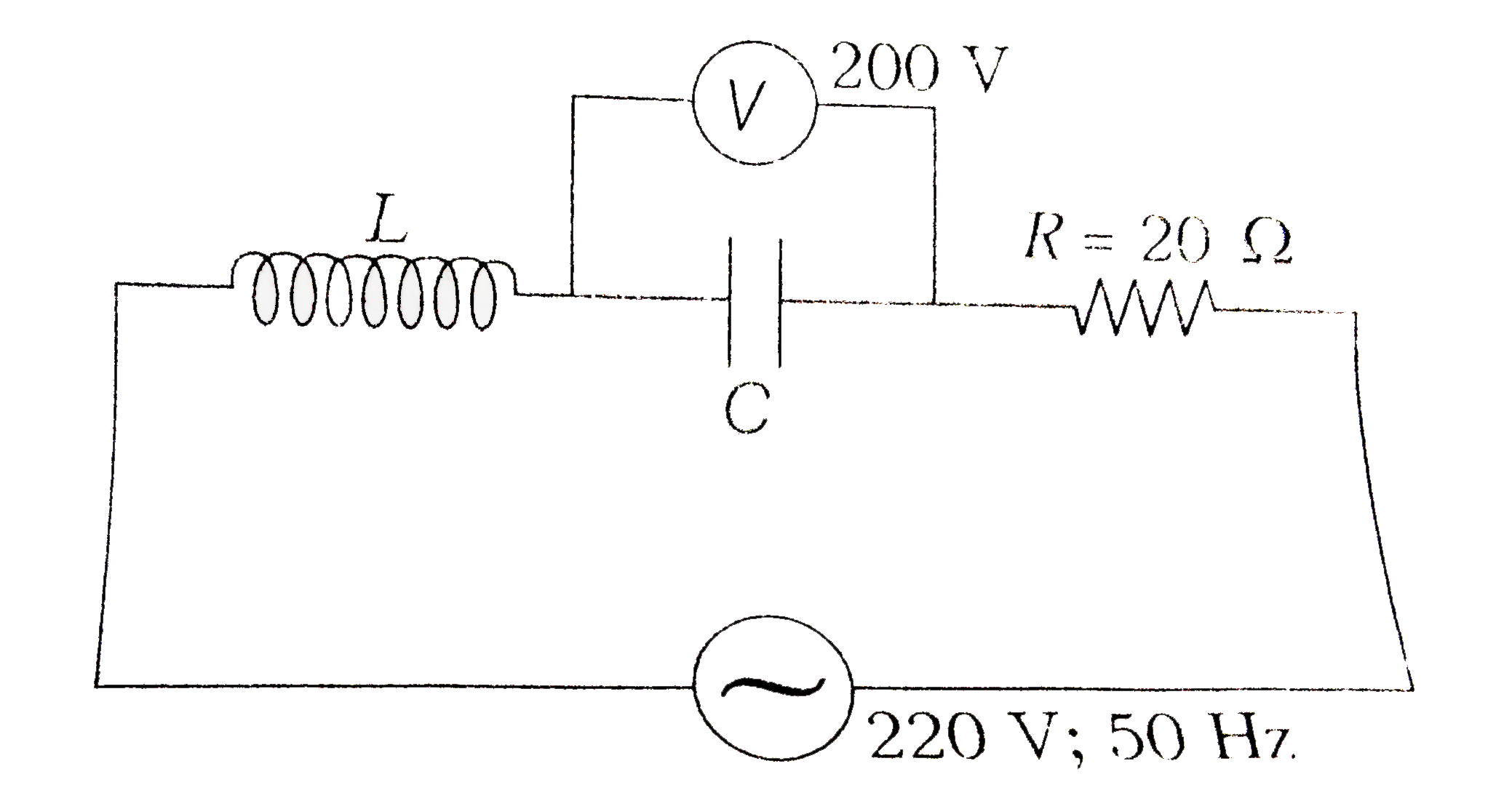In a series LCR circuit with an AC source, R=300Ω,C=20μF,L=1.0henry,εrms=50V and v=50πHz. Find (a) the rms current in the circuit and (b) the rms potential differences across the capacitor, the resistor and the inductor. Note that the sum of the rms potential differences across the three elements is greater than the rms voltage of the source.
The correct Answer is:(a)0.1A ,(b)50V,30V,10V(Note that the sum of the rms potential differences across the three elements is greater then the rms voltage of the source.)
To solve the problem step by step, we will break it down into parts (a) and (b) as specified in the question.
Given Data:
- Resistance, R=300Ω
- Capacitance, C=20μF=20×10−6F
- Inductance, L=1.0H
- RMS Voltage, ϵrms=50V
- Frequency, f=50πHz
Part (a): Finding the RMS Current in the Circuit
1. Calculate the angular frequency (ω):
ω=2πf=2π(50π)=100rad/s
2. Calculate the reactance of the capacitor (XC):
XC=1ωC=1100×20×10−6=10.002=500Ω
3. Calculate the reactance of the inductor (XL):
XL=ωL=100×1=100Ω
4. Calculate the impedance (Z) of the circuit:
Z=√R2+(XL−XC)2
Z=√3002+(100−500)2=√3002+(−400)2=√90000+160000=√250000=500Ω
5. Calculate the peak voltage (E0):
E0=√2⋅ϵrms=√2⋅50≈70.71V
6. Calculate the RMS current (Irms):
Irms=ErmsZ=50500=0.1A
Part (b): Finding the RMS Potential Differences
1. Calculate the RMS potential difference across the capacitor (VC):
VC=Irms⋅XC=0.1⋅500=50V
2. Calculate the RMS potential difference across the resistor (VR):
VR=Irms⋅R=0.1⋅300=30V
3. Calculate the RMS potential difference across the inductor (VL):
VL=Irms⋅XL=0.1⋅100=10V
4. Calculate the total potential difference across all components:
Vtotal=VR+VC+VL=30+50+10=90V
Summary of Results:
- (a) The RMS current in the circuit is 0.1A.
- (b) The RMS potential differences are:
- Across the capacitor: 50V
- Across the resistor: 30V
- Across the inductor: 10V
- The total potential difference across the components is 90V, which is greater than the RMS voltage of the source 50V.
- Resistance, R=300Ω
- Capacitance, C=20μF=20×10−6F
- Inductance, L=1.0H
- RMS Voltage, ϵrms=50V
- Frequency, f=50πHz
ω=2πf=2π(50π)=100rad/s
XC=1ωC=1100×20×10−6=10.002=500Ω
XL=ωL=100×1=100Ω
Z=√R2+(XL−XC)2
Z=√3002+(100−500)2=√3002+(−400)2=√90000+160000=√250000=500Ω
E0=√2⋅ϵrms=√2⋅50≈70.71V
Irms=ErmsZ=50500=0.1A
VC=Irms⋅XC=0.1⋅500=50V
VR=Irms⋅R=0.1⋅300=30V
VL=Irms⋅XL=0.1⋅100=10V
Vtotal=VR+VC+VL=30+50+10=90V
- (a) The RMS current in the circuit is 0.1A.
- (b) The RMS potential differences are:
- Across the capacitor: 50V
- Across the resistor: 30V
- Across the inductor: 10V
- The total potential difference across the components is 90V, which is greater than the RMS voltage of the source 50V.
Topper's Solved these Questions
- BOOK - RESONANCE ENGLISHCHAPTER - ALTERNATING CURRENTEXERCISE - Exercise -2 Part-114videos
ALTERNATING CURRENT
- BOOK - RESONANCE ENGLISHCHAPTER - ALTERNATING CURRENTEXERCISE - Exercise -2 Part-26videos
ALTERNATING CURRENT
- BOOK - RESONANCE ENGLISHCHAPTER - ALTERNATING CURRENTEXERCISE - HIGH LEVEL PROBLEMS11videos
ALTERNATING CURRENT
- BOOK - RESONANCE ENGLISHCHAPTER - ATOMIC PHYSICSEXERCISE - Advanved level problems17videos
ATOMIC PHYSICS
Similar Questions
Knowledge Check
- Question 1 - Select One
The rms value of potential difference V shown in the figure is
 AV0√3BV0CV0√2DV02
AV0√3BV0CV0√2DV02
(a) In a series L-C-R circuit with an AC source, R =300Ω, C = 20μF,L=1.0H,V0=50√2Vandf=50πHz. Find (i) the rms current in the circuit and (ii) the rms voltage across each element.
(b) Consider the situatiuon of the previous part. find the average electric field energy stored in the capacitor and the average magnetic field energy stored iun the coil .View SolutionIn an ac circuit the potential differences across an inductance and resistance joined in series are, respectively, 16 V and 20 V. The total potential difference across the circuit is
View SolutionIn an ac circuit the potential differences across an inductance and resistance joined in series are, respectively, 16 V and 20 V. The total potential difference across the circuit is
View Solutionin a series LCR circuit, what is the phase difference between VLandVC where VL is the potential difference across the inductor and VC is the potential difference across the capacitor?
View SolutionIn a series LCR circuit with an AC source (Erms50Vandv=50/πHz),R=300Ω,C=0.02mF,L=1.0H , which of the following is correct
View SolutionA resistor of 200Ωand a capacitor of 15.0μF are connected in series to a 220V,50Hz source.
(a) Calculate the current in the circuit .
(b) Calcutalte the voltage (rms) across the resistor and the inductor. Is the algebraic sum of these voltages more than the source voltage? If yes, resolve the paradox.View SolutionIn a series LCR circuit with an AC so (Erms=50V) and f=50/π Hz, R=300 ohm, C=0.02mF, L=1.0H, which of the follwing is correct
View Solution


